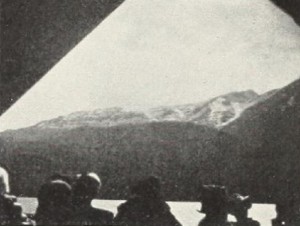"Activity at Croydon Airport in 1936, with focus on Imperial Airways' international flights. Original film was 33 minutes in length. This is possibly the only surviving representative of the very first Ten Best competition organised by 'Amateur Cine World' magazine." (EAFA Database)
"Kawakita’s Akogare was based on the film footage that he shot on 8mm reversal film at the locations where Gosho Heinosuke was filming his own commercial studio film titled Akogare... his film was not a behind-the-scenes footage of Gosho’s commercial production but rather a stand-alone narrative film that Kawakita himself shot and edited." - Noriko Morisue, "Filming the Everyday: History, Theory, and Aesthetics of Amateur Cinema in Interwar and Wartime Japan" (Yale University: PhD Dissertation, 2020): 158.
"Sid and Charlotte take a trip to Prudhoe Bay, the Alaskan pipe-line, and other points of interest in Alaska." UCLA Film & Television Archive.

"It is only natural that a picture that has to do with a trip to Alaska would have a great deal of scenic footage. How to make that scenic footage, in which there is no action, interesting and seem to have action was the thing that Denny accomplished." Home Movies, June 1939, 227.

"Alan Probert's Alaskan Gold is an extremely competent, step by step analysis of the placer mining of gold, from the early days of the Gold Rush to today's massive and highly integrated industrial systems. Mr. Probert shows an enormous amount of technical detail, but his explanations help the layman avoid most of the boredom frequently encountered in such treatments." Movie Makers, Dec. 1949, 468.

El filme comienza con una descripción de como iniciar en el Cross. Vemos un campeonato de Cross desarrollarse en los alrededores de Álava y la premiación a los
ganadores. Un joven se ilusiona por ser corredor de Cross.
The film begins with a description on how to begin cross country running. Then a cross-country championship is seen developing in the surroundings of Alava, and then we see the awards ceremony for the winners. A young man is seen getting excited about becoming a cross country runner.

El filme comienza con personas preparándose para la fiesta del pueblo. Gente cocina, decora, come y bebe vino. A esto siguen imágenes de una competencia de motocicletas, gente en las calles comprando largas tiras de ajo, competencias en el pueblo, arquitectura y esculturas, calles muy llenas y finalmente tomas de juegos de feria durante la noche.
The film begins with people getting ready for a party of the town. People are cooking, decorating, eating and drinking wine. There are images of a motorcycle competition, people in the streets buying large strips of garlic, competitions in the town, architecture and sculpture, very crowded streets and finally a few shots of games in a fair at night.

"With the help of almost unbelievable luck from the weather man, Helen C. Welsh has achieved a high level of what is essentially newsreel filming. Her subject matter is in itself appealing — displays of tulips in a public park, children wearing amazing holiday headgear, dancers performing Old World figures, all climaxed by the pageantry of the coronation of a new king and queen of the festival. But Miss Welsh handles it expertly. Her viewpoints are varied and her camera work accomplished, while a wisely sparse and well recorded narrative ties the whole presentation into an attractive package. Albany's Tulip Festival is colorful, entertaining and fulsome as a record of a city's spring holiday." Movie Makers, Dec. 1950, 464.

"Devotees of the hilarious poem about the Lancashire couple and their son Albert would not fail to delight in Albert and the Lion, filmed by A. Scott Moorhouse. It portrays the misadventures of young Albert and his parents on their holiday at Blackpool, an English seaside resort. The story of how the objectionable young Albert, who carried a stick with a " 'orse's 'ead 'andle,'' was eaten by the lion is told in a highly satisfying manner. The scenes of the outlandishly costumed trio and their tribulations are timed to accompany a recitation of the poem. The characters are perfectly chosen and also outfitted to perfection. Although filmed at a Toronto zoo, the movie might well have been taken at the famous English resort of the poem. Mr. Moorhouse's handling of the players was masterly, and he made the best of his filming opportunities." Movie Makers, Dec. 1940, 601.

"Scenes shot around Aldeburgh and the surrounding neighbourhood during the late 1920s" (EAFA Database).
Total Pages: 203